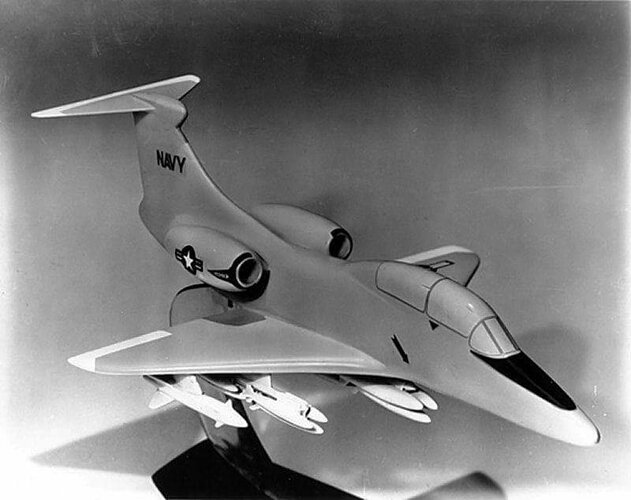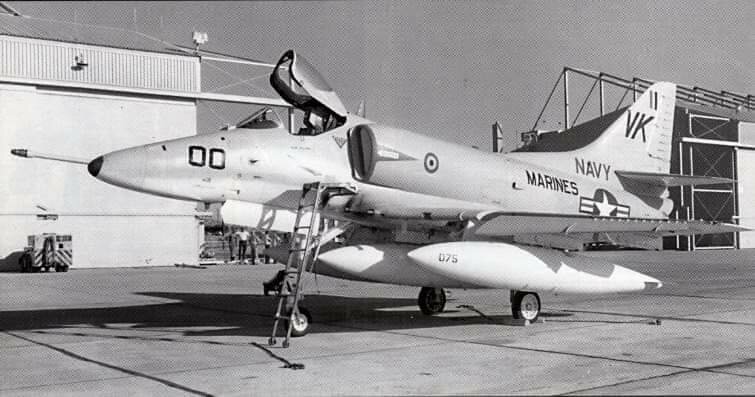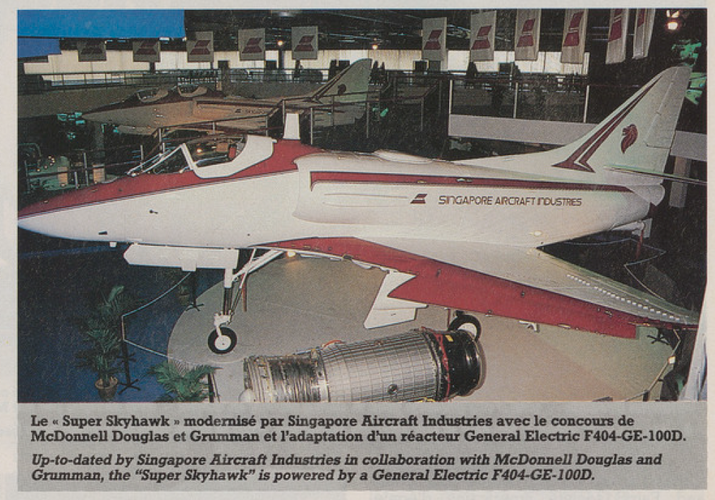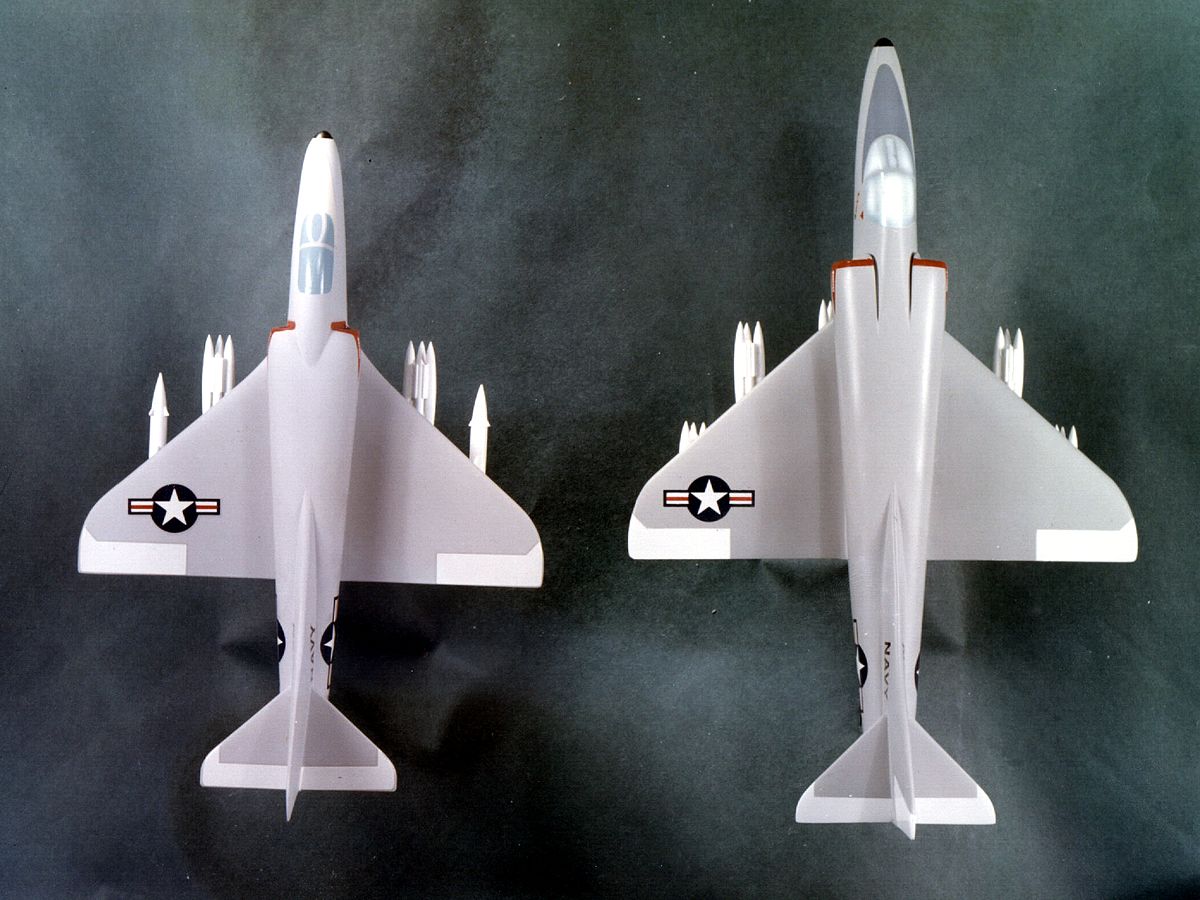That's a much larger plane! (where's the "mind blown" emoji?)
The A4D-6 was an enlarged A4D-5 (A-4E) and was Douglas' entry to the U.S. Navy's 1962 VAL (light attack aircraft) competition.
As the VAL was specified by the USN to use the TF30 (non-afterburning) the fuselage was re-designed for the fatter and longer engine* - and the wings enlarged to increase the payload to where the USN required.
No A4D-6 was built, as the competition was won by Ling-Temco-Vought with what later became the A-7
Corsair II.
* J52: 117" long, 30.2" diameter, 8,500 lb.s.t. - 9,300 lb.s.t. A-4E (32.1" dia & 11,200 lb.s.t. A-4M)
TF30: 125" long, 40.06" diameter, 11,350 lb.s.t A-7A (13,400 lb.s.t. A-7C)
C as a prefix is usually used for anything in Canadian service, and in the late 1950s the Canadians did have a carrier...
Until 1962, the Canadian Navy had operated F2H-3 Banshee fighters (acquired used from the USN) from its sole carrier, HMCS Bonaventure.
At the final Naval Board meeting in July 1964 the A-4E fighter was approved for Bonaventure (then undergoing refit). This was not approved by the Government (see below).
By 1966 the Naval Staff, as it had previously existed, was disbanded. The Naval Board had been abolished.
By 1967 Bonaventure returned to operational service with her complement of newly improved CSF-3 Trackers and Sea King helicopters. The often criticized refit, although over budget, provided the carrier an estimated 10 year period of operations with an enhanced performance provided by the various modifications to operational equipment and crew habitability. In spite of the size and speed limitations of the carrier, flying operations and the ASW performance of Bonaventure and her escort group over the next 18 months was second to none in the ongoing NATO exercises involving both the USN and other western navies.
Maritime Commander, Vice Admiral O'Brien, however, was under increasing pressure from the highest levels at CFHQ.
In one graphic example he was told to provide no further fuel for Bonaventure, which was scheduled for a major exercise. He managed to bypass that directive by filling the supply ship Provider with fuel and then transferring it to the carrier.
In the spring of 1969, with cutbacks facing the forces, rumors began circulating that the carrier was a particular target insofar as Prime Minister Trudeau's announced change in defense policy included a phased reduction of the Canadian Commitment to NATO.
On the night of 20 September 1969 Bonaventure and her escort group were in the midst of Exercise Peace Keeper, one of the most intensive and wide-ranging series of maneuvers to date involving major fleet units of the USN, RN and other NATO Forces. The bombshell arrived in the form of a CBC short wave news service. Bonaventure was to be scrapped, and VS 880 (the Tracker squadron) was slated for disbandment.
The duplicity of the new Defense Minister Leo Cadieux together with his insensitivity was unpardonable. Only one week earlier he had dismissed a report of Bonaventure's retirement as pure speculation. Vice Admiral O’Brien had assured Captain Jim Cutts, the CO of the carrier, that he would inform Cutts if there were to be any change of status in the carrier. Even O'Brien, the navy's top operational commander, was not given the courtesy of being advised prior to the media that his most valuable fleet asset was being scrapped. Also humiliated was the Parliamentary Committee aboard Bonaventure who had prepared a complete dossier of the role and scope of Maritime Command for presentation to Parliament.
So yes, the CA-4E and CA-4F were designations for the proposed Canadian Skyhawks for both the Navy and Air Force. The F-5A was selected instead, in part as behind the scenes the decision to get rid of Bonaventure was already gaining support so only the Air Force's needs were taken into account.
CSF-1 and CSF-2 were designations for S2F (S-2) Trackers built for the Canadian Navy by de Havilland Canada, and CSF-3 were upgraded CSF-2s.






